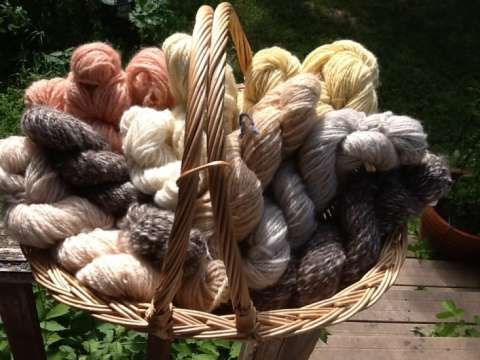Snow on the Mountain

I have recently found a use for this invader that makes me feel much better about giving my garden over to it. I decided to try to dye wool with it. It was a round-about journey but I ended up with beautiful results. The best part is that I get to decapitate the Snow on the Mountain plants. This picture was taken after I had cut what I needed!
I started the process with Asparagus. I cooked some for supper one night and noticed a beautiful green color in the water. We ate that asparagus, but I went out and picked a bunch more, about two pounds. I brought that in, cleaned it and chopped it into 2" pieces. I simmered it in two gallons of water for one hour and let it sit in the liquid over night. The next day I drained and strained it and added .33g. Alum for a mordant. I also added .18g. cream of tartar for an assist. I placed three ounces of white roving into the pot and simmered it for about one hour. I shut the heat off and left the wool in the dye bath for about 36 hours. After the first twelve or so hours I added .18g of citric acid as well. The pot still had a nice green color, but the yarn remained white. Enter the Snow on the Mountain.
I removed the yarn from the pot, left the liquid and filled the pot with chopped up Snow on the Mountain. I put about one and a half plastic grocery bags in and pushed it all under the water. The mordant (alum) and cream of tartar was still in the water. I did not add more. I simmered this for about an hour, let it cool some, and added the yarn back to the pot. I simmered the yarn for an hour and removed it from the heat.

The dye bath turned a very soft, lemony yellow. It also smelled very bad so I put it outside. I let this stand another 36 hours. The color didn't really go into the wool until the last twelve hours.
In this particular case the mordant was added directly to the dye bath. This is easier than mordanting the yarn and then placing it in the dye bath. The drawback is that if you want to experiment with other mordants you can't because the dye bath and not the wool has the mordant. There are several other things that can be used as mordants such as tannin, vinegar, and heavy metals such as silver, chrome, iron, tin or copper. The metals are quite toxic so disposing of them is a problem. Each will produce a different color with the same dye stuff. I have decided that I will use alum as a mordant in the interest of keeping this adventure safe and focused. I can't imagine I will run out of colors by using just alum!
The yarn, when removed from the dye bath was washed with hot water and Eucalan soap. It was then hung outside to dry. The result is a beautiful soft yellow, the color of lemonaide. I now have three ounces of wool ready for spinning.
(I tried several times to get a good photo of the wool, but could not capture the color. I bought a package of colored index cards with yellow, pink, blue and green cards. The yellow matches the yellow wool, if that helps).


